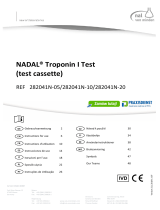
POLSKI
Test NADAL® RSV (Nr prod. 491005)
nal von minden GmbH • Carl-Zeiss-Strasse 12 • 47445 Moers • Germany • info@nal-vonminden.com • www.nal-vonminden.com 14
1. Zastosowanie
Test NADAL® RSV jest immunochromatograficznym testem
typu Lateral Flow do jakościowego oznaczania RSV
w aspiratach i wymazach nosogardzieli. Test ten służy jako
środek pomocniczy przy diagnozie infekcji dróg oddechowych,
wywołanej przez RSV i przeznaczony jest wyłącznie do
profesjonalnego użytku.
2. Wprowadzenie i znaczenie diagnostyczne
Wirus RSV jest najczęstszym wirusem dróg oddechowych
u noworodków i małych dzieci. Infekuje praktycznie wszystkie
dzieci do wieku dwóch lat. U większości dzieci wirus powoduje
objawy, które podobne są do zwykłego przeziębienia.
U noworodków, które urodziły się za wcześnie lub/oraz mają
przewlekłą chorobę płuc, RSV może powodować zagrażającą
życiu chorobę. Przed wprowadzeniem Synagis®, choroby RSV
prowadziły rocznie do ok. 125.000 hospitalizacji. U ok 2%
noworodków istniało wysokie ryzyko śmierci. Objawy to
gorączka, katar i kolejne ciężkie objawy jak kaszel, ciężki
i szybki oddech jak również sapanie.
3. Zasada działania testu
Test NADAL® RSV jest immunochromatograficznym testem
typu Lateral Flow, do jakościowego oznaczania RSV
w aspiratach i wymazach nosogardzieli.
Kombinacja konjugatów monoklonalnych przeciwciał-
barwników o poliklonalnych przeciwciałach fazy stałej
zastosowana została w teście NADAL® RSV, aby selektywnie
i z wysokim stopniem czułości i swoistości, oznaczać RSV.
Po pobraniu oraz przygotowaniu próbki, kilka kropli dodawana
jest do zagłębienia próbki () testu kasetowego.
Podczas gdy próbka wędruje wzdłuż membany, konjugaty
przeciwciało-barwnik wiążą się z antygenami RSV (jeżeli te
zawarte są w próbce), przy czym powstają kompleksy
przeciwciało-antygen. W przypadku pozytywnego wyniku,
kompleksy łączą się z poliklonalnymi przeciwciałami
w obszarze linii testowej testu kasetowego i powodują
pojawienie się różowej linii. W razie nieobecności RSV, nie
pojawia się linia w obszarze linii testowej testu kasetowego.
Mieszanina reakcyjna wędruje dalej wzdłuż membrany testu
kasetowego. Niezwiązane koniugaty wiążą się z odczynnikami
w obszarze linii kontrolnej, przy czym powstaje różowa linia,
która wskazuje, że dodana została wystarczająca ilość próbki
i że membrana jest wystarczająco nasączona.
4. Materiały zawarte w zestawie
• 20 testów kasetowych NADAL® RSV
• 20 pipet jednorazowych
• 20 wymazówek
• 2 buteleczki z buforem „Buffer“ (11 ml)
• 1 instrukcja obsługi
5. Dodatkowo potrzebne materiały
• Stoper
• Probówki z tworzywa sztucznego (dla min. 1ml buforu)
• Pipeta 0,5 ml
• Ewentualnie pipeta 1 ml
• Odpowiedni czynnik rozcieńczający (np. sterylny roztwór
soli kuchennej dla aspiratów)
• Cewnik lub aspirator (dla aspiratu)
6. Ważność i przechowywanie odczynników
Zestawy testowe NADAL® RSV powinny być przechowywane
w temperaturze 4-30°C i stosowane do daty użyteczności
podanej na opakowaniu. Nie zamrażać zestawów testowych.
Testów nie używać po upływie daty ważności.
7. Ostrzeżenia i środki ostrożności
• Tylko do profesjonalnej diagnostyki in-vitro.
• Przed przeprowadzeniem testu należy dokładnie przeczytać
całą instrukcję obsługi.
• Nie używać testu po upływie daty użyteczności podanej na
opakowaniu.
• Nie używać testu, jeżeli opakowanie foliowe jest
uszkodzone.
• Nie używać ponownie tych samych testów.
• Nie dawać próbek na pole reakcyjne (pole wyniku).
• Aby uniknąć zanieczyszczenia, nie dotykać pola reakcyjnego
(pola wyniku) oraz obszaru zanurzeniowego.
• W celu uniknięcia zanieczyszczenia krzyżowego należy
używać każdorazowo nowej probówki dla każdej próbki.
• Nie wymieniać lub mieszać elementów składowych
z różnych zestawów testowych.
• Rozlane płyny dokładnie wyczyścić odpowiednim środkiem
dezynfekującym.
• Nie jeść, nie pić, nie palić w obszarze pracy z próbkami lub
zestawem testowym.
• Podczas kontaktu z próbkami, stosować odzież ochronną,
taką jak fartuch, jednorazowe rękawiczki oraz okulary
ochronne.
• Traktować wszystkie próbki tak, jakby zawierały odczynniki
zakaźne. Należy zwrócić uwagę na zaistniałe środki
ostrożności dla mikrobiologicznego ryzyka, podczas
wszystkich procesów jak również standardowych dyrektyw
dla odpowiedniej utylizacji próbek.
• Test ten zawiera produkty pochodzenia zwierzęcego.
Certyfikowana wiedza o pochodzeniu i/lub o stanie
sanitarnym zwierząt nie gwarantują braku przenoszonych
patogenów. Dlatego zaleca się, aby te produkty były
traktowane jako potencjalnie zakaźne. Posługując się nimi,
należy przestrzegać standardowych środków ostrożności
(np. unikać połknięcia lub wdychania).
• Wilgoć oraz wysokie temperatury mogą mieć wpływ na
wyniki testu.
• Zużyte materiały testowe powinny być zutylizowane
zgodnie z lokalnymi zaleceniami.
8. Pobieranie, przygotowywanie i przechowywanie próbek
Wskazówki:
• Próbki RSV powinny być zbierane wyłącznie z dróg
oddechowych.
• Do pobrania aspiratu z nosogardzieli użyć gruszki z kanką
lub cewnika.
• Można stosować wymazy z nosogardzieli. Są to jednak
niższej jakości próbki niż aspiraty z nosogardzieli.
• Jeżeli wymazówka nie będzie badana bezpośrednio,
powinna być przechowywana w czystym i suchym
pojemniku (nie zawarty w zestawie testowym) i przebadana
w ciągu najbliższych 24 godzin.
• Nie używać podłoży transportowych do przechowywania.






















